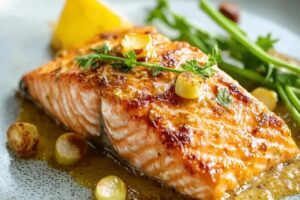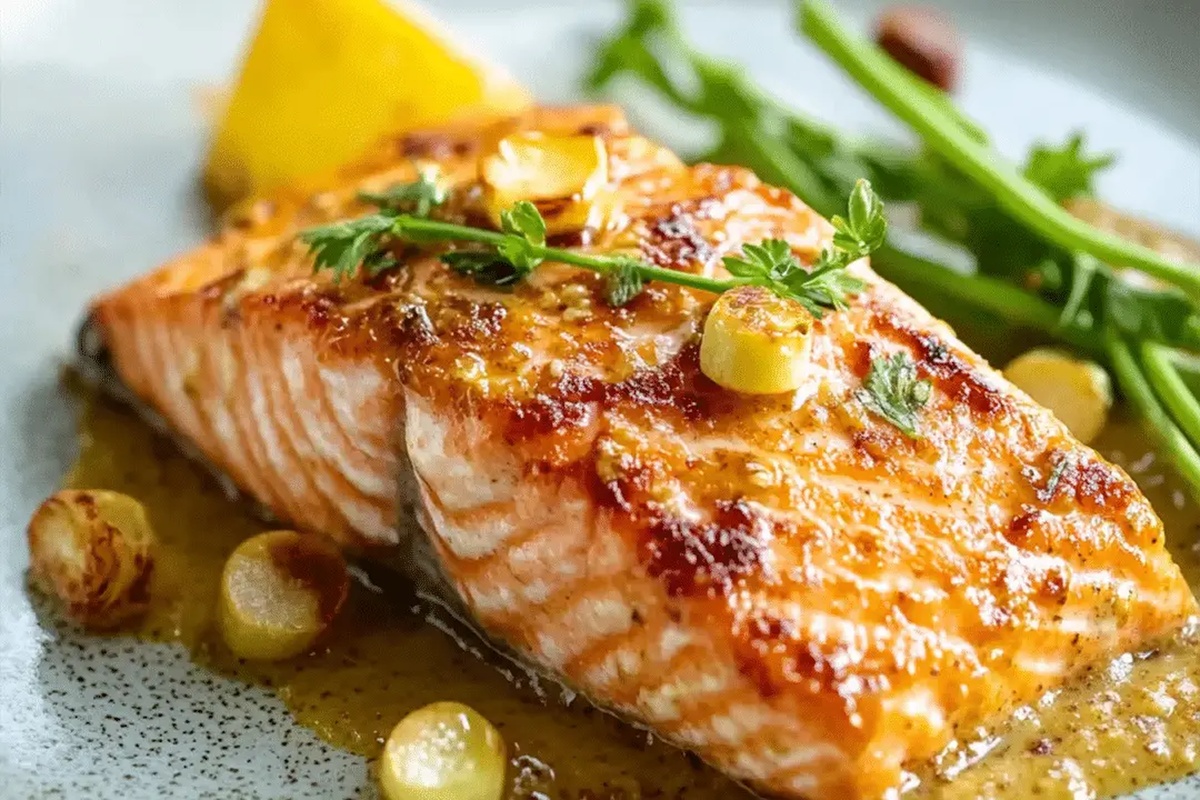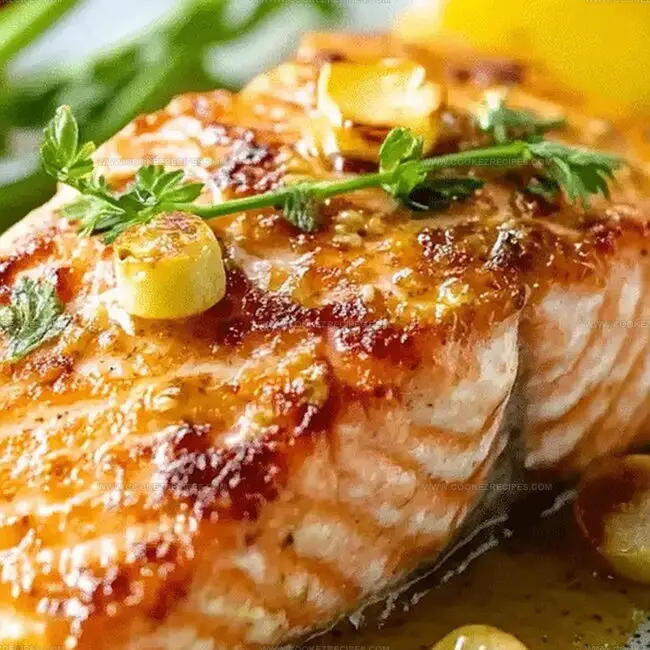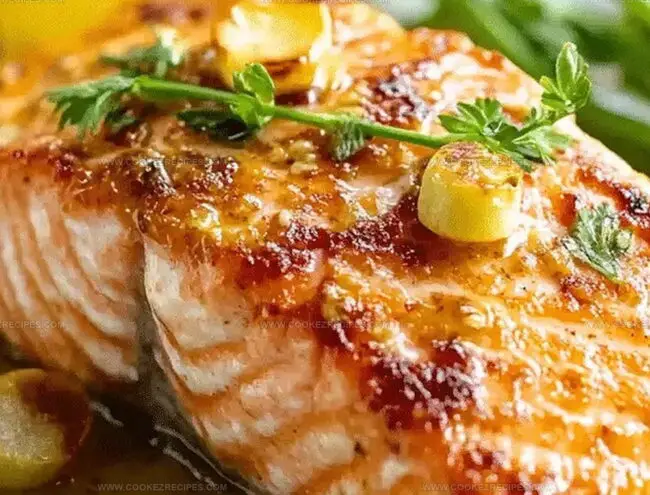Crispy Baked Dijon Salmon Recipe: A Tangy Weeknight Wonder
Crisp ocean breezes and tangy dijon salmon dance together in a culinary symphony that promises pure delight.
Mediterranean herbs whisper secrets of flavor across delicate fish fillets.
Salmon becomes an art form when kissed by sharp mustard and aromatic seasonings.
Weeknight dinners demand something extraordinary, and this recipe delivers pure elegance.
Light, zesty notes pirouette across your plate with unexpected grace.
You’ll discover how simple ingredients can create restaurant-quality magic in minutes.
Let’s transform an ordinary evening into a gourmet celebration that sparks joy and satisfaction.
Baked Dijon Salmon That Balances Health And Flavor
Salmon Baked in Dijon Mustard Blend
Fish:Coating Mixture:Topping:Seasoning:Garnish:Instructions For Baked Dijon Salmon
Step 1: Warm Up the Oven
Crank the oven to a toasty 400°F and grab a baking sheet.
Line it with parchment paper for easy cleanup.
Gently place salmon fillets skin-side down, ready for their flavor transformation.
Step 2: Create the Flavor Glaze
Grab a small bowl and whisk together:Let this magical mixture sit and wait for its moment.
Step 3: Prepare the Crunchy Topping
In another bowl, mix together:This will be the golden crown for your salmon.
Step 4: Dress the Salmon
Brush each salmon fillet with the honey mustard glaze.
Sprinkle with a pinch of salt and pepper to awaken the flavors.
Step 5: Add the Crunchy Crown
Generously sprinkle the pecan bread crumb mixture over the top of each salmon fillet.
Make sure it’s evenly distributed for maximum crunch.
Step 6: Bake to Perfection
Slide the baking sheet into the oven.
Bake for 12-15 minutes.
The salmon is ready when it flakes easily with a fork.
Thicker fillets might need a few extra minutes.
Step 7: Serve and Enjoy
Pull out the salmon and add a bright lemon wedge on the side.
Serve immediately while the topping is crisp and the fish is tender.
Salmon Tips With Baked Dijon Perfection
Best Practices to Store Baked Dijon Salmon
Sharp Flavors With Dijon Salmon
Zesty Styles of Baked Dijon Salmon
FAQs
Yes, you can substitute salmon with other firm fish like halibut, cod, or sea bass. Just adjust cooking time based on the thickness of the fish.
The salmon is done when it flakes easily with a fork and reaches an internal temperature of 145°F. The flesh should look opaque and separate easily.
Replace regular breadcrumbs with gluten-free breadcrumbs or crushed gluten-free crackers. Alternatively, use almond meal or crushed gluten-free cornflakes for a crunchy topping.
You can prepare the salmon with the honey mustard and breadcrumb mixture up to 2 hours before baking. Keep it refrigerated and add a few extra minutes to the cooking time if the fish is cold.
Print
Baked Dijon Salmon Recipe
- Total Time: 40 minutes
- Yield: 4 1x
Description
Succulent Dijon salmon brings French-inspired elegance to your dinner table with minimal effort. Crisp herb-crusted fish promises a delightful blend of tangy mustard and fresh herbs you’ll savor in every delectable bite.
Ingredients
Main Ingredients:
- 4 salmon fillets (4 ounces/113 grams each)
- 1/4 cup dry bread crumbs
- 1/4 cup very finely chopped pecans
Sauce and Seasoning Ingredients:
- 3 tablespoons Dijon mustard
- 1/4 cup butter, melted
- 1 1/2 tablespoons honey
- 4 teaspoons chopped fresh parsley
- Salt, to taste
- Pepper, to taste
Garnish:
- 1 lemon
Instructions
- Prepare the oven environment by heating to 400°F (200°C) and lining a baking sheet with parchment paper, positioning salmon fillets skin-side down.
- Create a flavorful glaze by whisking melted butter with Dijon mustard and honey in a compact mixing vessel.
- Craft a crispy topping by combining bread crumbs, finely chopped pecans, and fresh parsley in a separate mixing bowl.
- Generously coat each salmon fillet with the honey mustard mixture, ensuring even coverage and enhancing the flavor profile.
- Season the glazed fillets with a delicate sprinkle of salt and freshly ground black pepper to elevate the taste.
- Distribute the nutty breadcrumb mixture evenly across the salmon’s surface, creating a textured and golden-brown crust.
- Transfer the prepared salmon to the preheated oven and bake for 12-15 minutes, checking for a delicate flakiness in the thickest section of the fillet.
- For thicker fillets, extend cooking time slightly to ensure complete and even cooking throughout.
- Finish the dish by garnishing with a vibrant lemon wedge, adding a bright, citrusy accent to the rich salmon.
- Serve the salmon immediately while the crust remains crisp and the fish retains its succulent texture.
Notes
- Use room temperature salmon to ensure even cooking and prevent dry edges.
- Pat salmon dry with paper towels before seasoning to help the breadcrumb mixture adhere perfectly.
- Swap pecans with almonds or gluten-free breadcrumbs for dietary variations and added crunch.
- Prevent overcooking by checking salmon’s internal temperature, which should reach 145°F for food safety while maintaining moisture.
- Prep Time: 10 minutes
- Cook Time: 30 minutes
- Category: Dinner
- Method: Baking
- Cuisine: French
Nutrition
- Serving Size: 4
- Calories: 350
- Sugar: 3 g
- Sodium: 250 mg
- Fat: 25 g
- Saturated Fat: 10 g
- Unsaturated Fat: 15 g
- Trans Fat: 0 g
- Carbohydrates: 12 g
- Fiber: 1 g
- Protein: 24 g
- Cholesterol: 70 mg




Daniel Bruns
Founder & Culinary Innovator
Expertise
Recipe development for home cooks, Nutritional analysis and meal planning, Culinary education and food writing
Education
Auguste Escoffier School of Culinary Arts
Diploma in Culinary Arts and Operations
Focus: Classical and contemporary cooking techniques, Culinary entrepreneurship and kitchen management, Menu development and food cost analysis
Daniel’s story started with flour on his face and a pie in the oven at his grandma’s house. He later sharpened his skills at the Auguste Escoffier School of Culinary Arts.
His goal? Recipes so simple you’ll want to cook every night. When he’s not whipping up one-pan wonders, Daniel’s outside picking herbs, hosting neighborhood cook-offs, or baking chocolate cakes with his kids, messy, sweet, and unforgettable.